Leadership
July 14, 2025
6
Min
Leadership Development Programs: What Works (and What Doesn’t)
Leadership
|
We’ve all seen it happen: senior leaders greenlight an ambitious development program, full of off-sites, 360 feedback, and executive coaching. Everyone nods along, eager to grow. Six months later? Not much has changed. Behaviours revert. The culture barely shifts. The ROI conversation begins... and fizzles.
Here’s the real question: what actually works when it comes to leadership development? And what gets in the way?
This post draws on two decades of coaching and strategy work with leadership teams. We’ll unpack the strategies that drive lasting change, call out common misfires, and share a refined framework we’ve seen generate meaningful, measurable outcomes.
Leadership development isn’t just a perk or a pet project. At its best, it’s a force multiplier.
According to McKinsey, organisations in the top quartile for leadership effectiveness were 13 times more likely to outperform their competition on key business metrics.
This matters because leadership shapes the tone, pace, and priorities of an organisation. Culture, decision quality, team alignment, innovation velocity - all hinge on how leaders think, act, and model behaviour.
So when leadership development is done right, it unlocks competitive advantage. When done poorly, it becomes corporate theatre.
Effective leadership development isn’t built on modules. It’s built on momentum.
We call our model The 4 Levers of Sustainable Leadership Growth:
Let’s break these down.
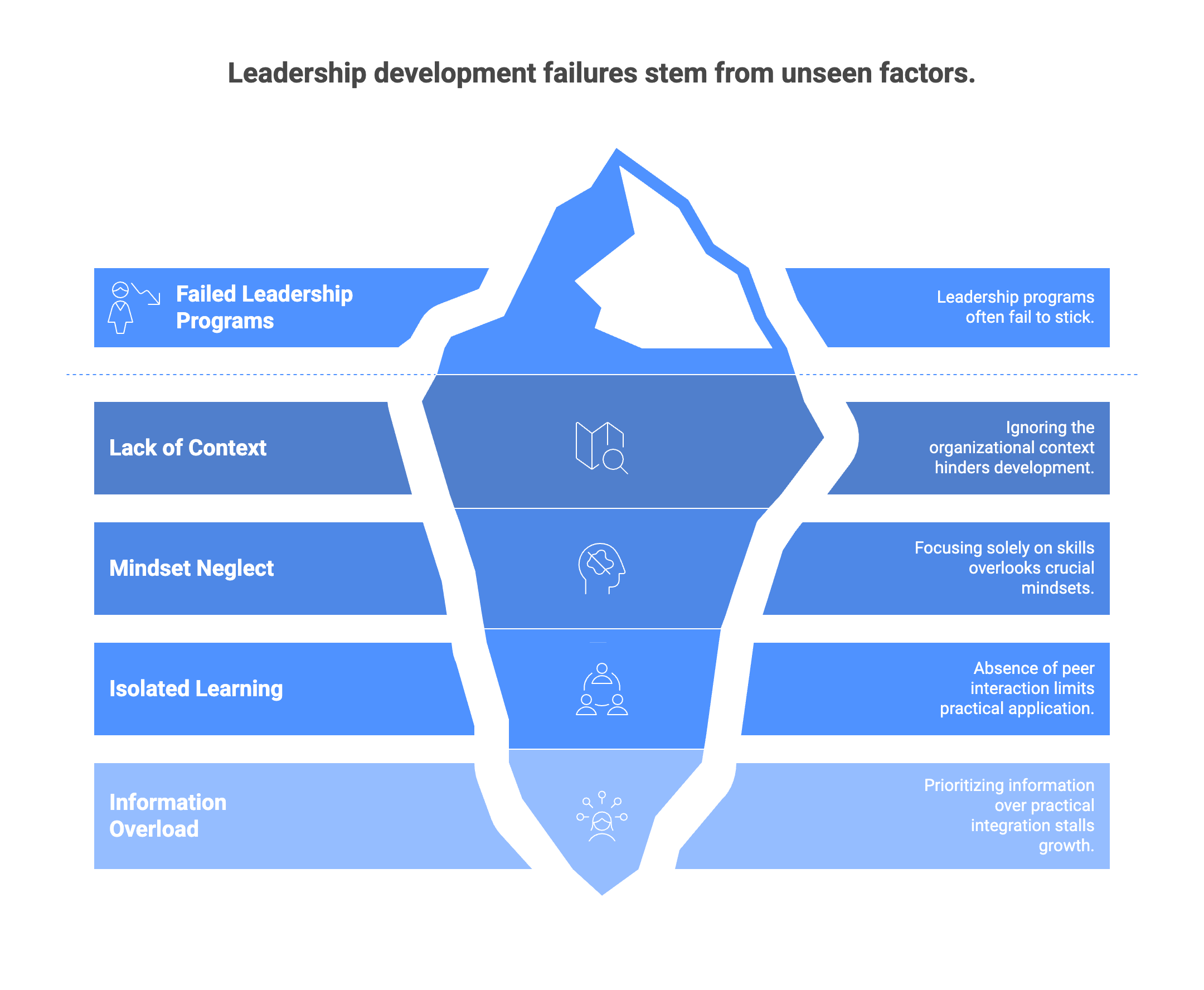
Most programs begin with what leaders need to learn. We start with why now?
Leadership isn’t one-size-fits-all. A brilliant coaching toolkit means nothing if what’s really needed is strategic decision-making under pressure. And vice versa.
Effective programs anchor in the business context:
We’ve seen a regional bank leapfrog competitors not by generic leadership modules, but by embedding development in their pivot to digital-first customer service. Leaders practised real-time scenario planning, stakeholder communication, and cross-functional influence - because those were the muscles their transformation needed.
Reflection prompt:
Where is your business heading - and what leadership patterns will no longer serve you there?
Micro-action: Before designing your next program, run a 1-hour cross-functional pulse to identify strategic tensions and growth gaps.
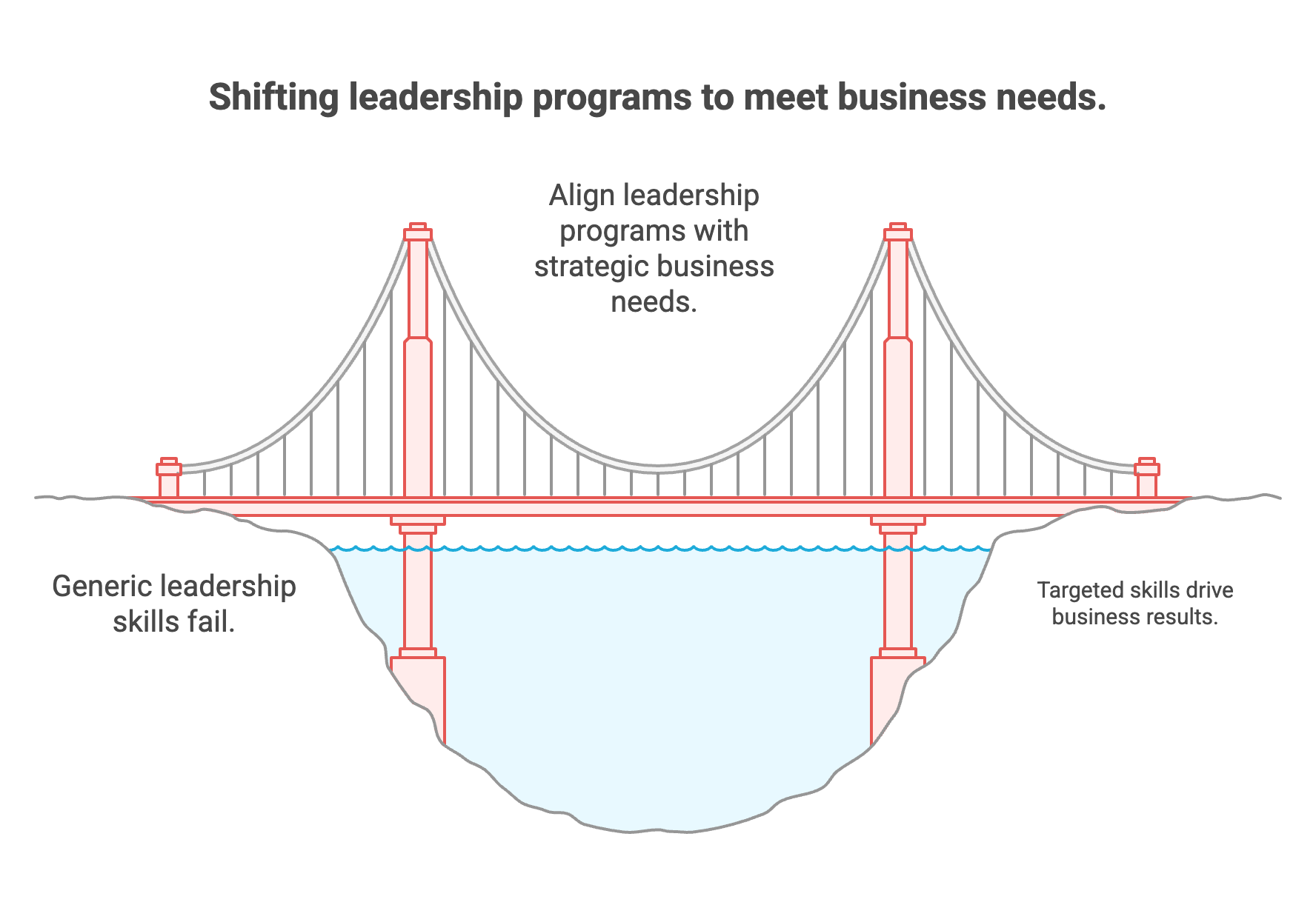
Too many programs teach behaviours without challenging beliefs.
But leadership is inside-out work.
If a leader sees conflict as dangerous, no amount of “crucial conversations” training will land.
If someone believes strategy is for the C-suite only, they won’t step into system-level thinking.
We build in structured self-reflection, coaching, and leadership narratives.
Because real growth happens when people question their default scripts and choose new ones.
Take one client: a senior ops leader who always defaulted to control. Through peer coaching and reframing exercises, he saw how fear of being seen as weak shaped his style. That shift unlocked delegation, trust, and a three-fold jump in team performance scores.
Micro-action: Introduce a “beliefs audit” at the start of any development cycle. Ask:
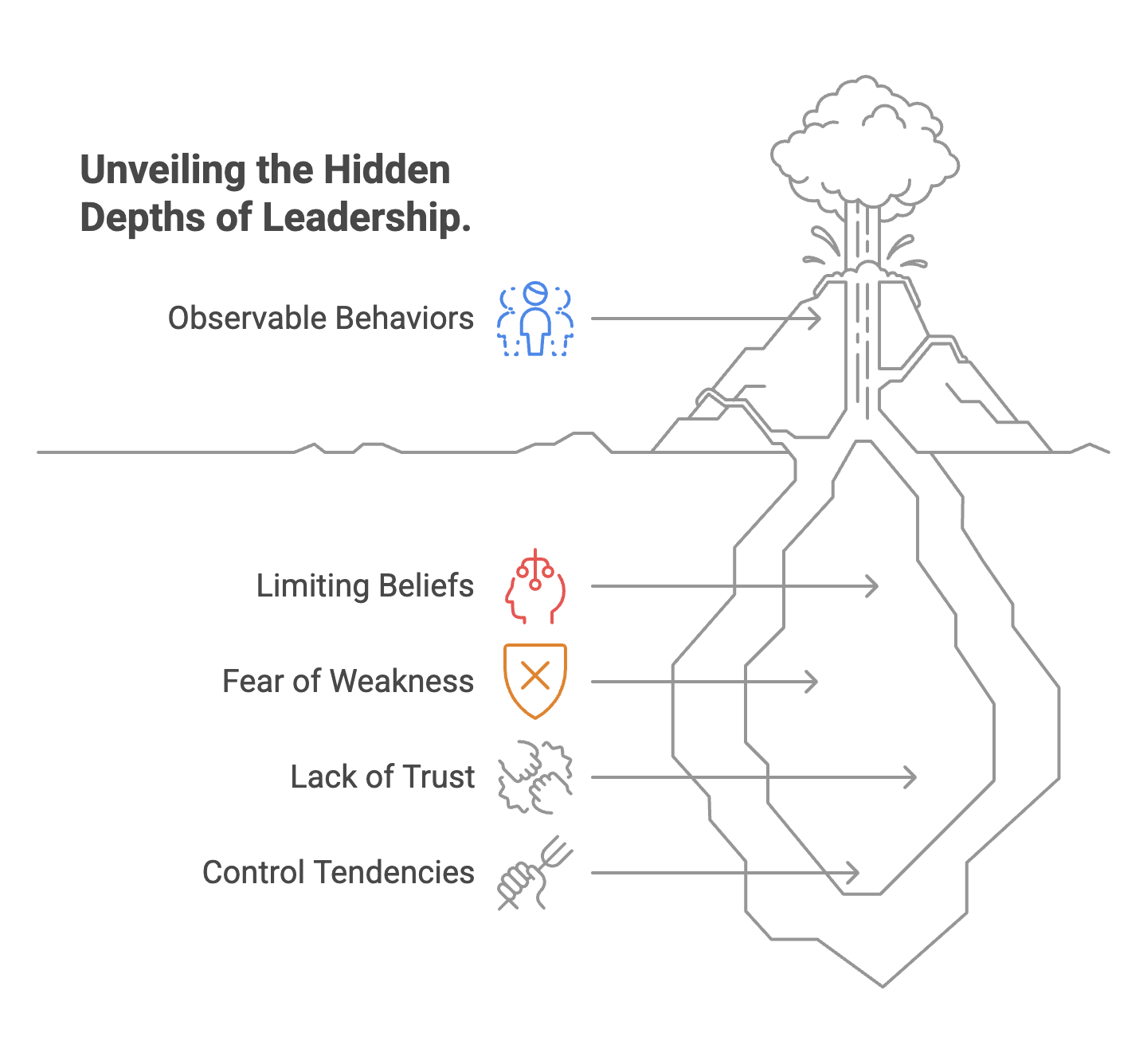
People learn more from each other than from experts. Especially at senior levels.
We’ve seen exponential value in cross-functional peer forums. When a product head and a finance lead unpack their blind spots together, something shifts. Trust builds. Silo walls crack. Vulnerability becomes productive.
The key is structure:
And yes, it gets uncomfortable. But that’s where growth lives.
Micro-action: Create monthly “Leadership Labs” where peers bring real challenges, coach each other, and reflect out loud. Rotate facilitation.
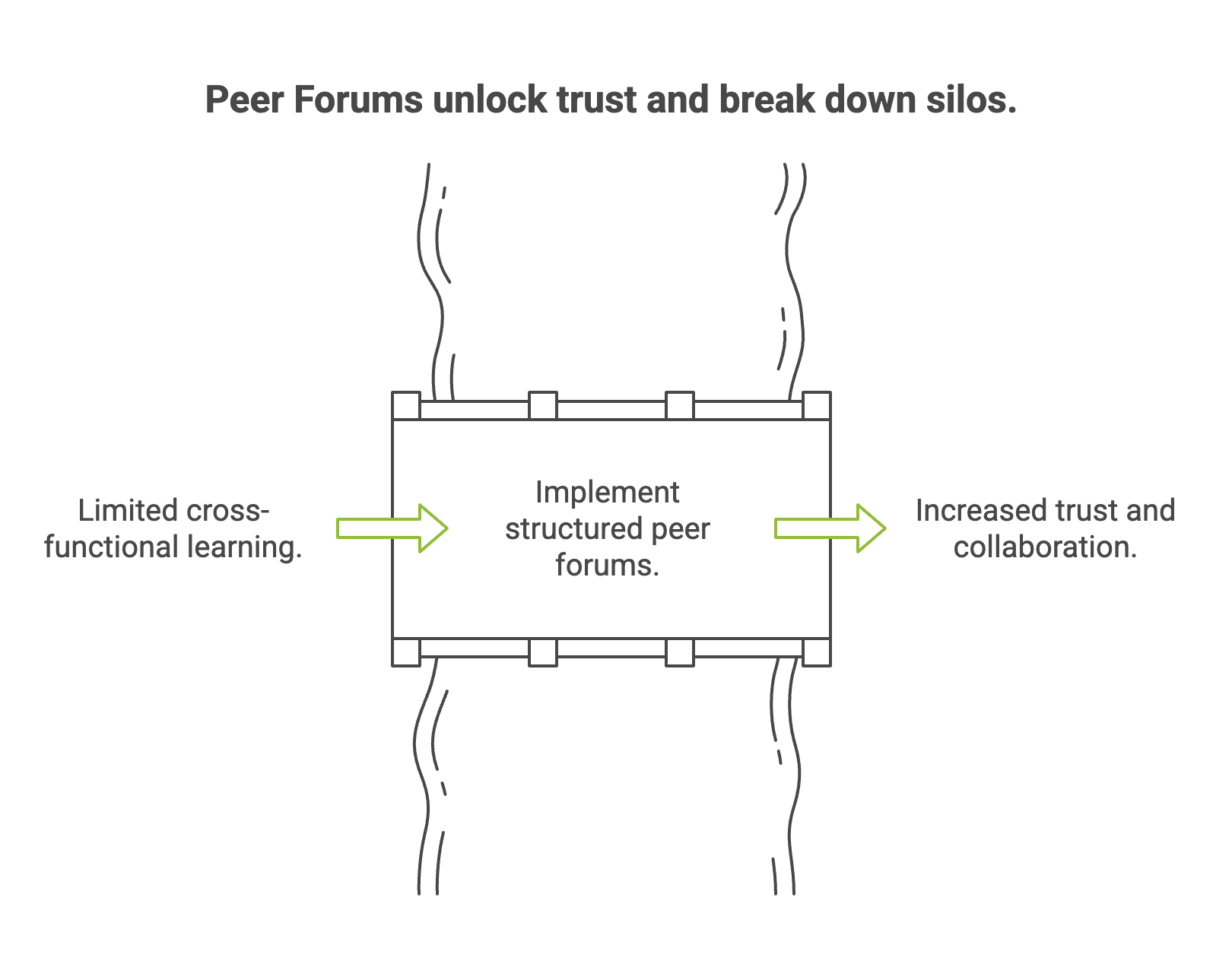
The most common failure mode? Treating leadership development as an event, not a process.
You can’t “install” leadership like software.
You embed it through rhythm, reinforcement, and reflection.
That’s why we design learning arcs over 6–12 months, with touchpoints embedded in business meetings, coaching, and feedback loops.
It’s also why we avoid generic KPIs. Instead, we link development goals to strategic outcomes:
Micro-action: Pair each learning theme with a “field assignment” directly tied to current business goals. Then debrief in team meetings, not just in workshops.
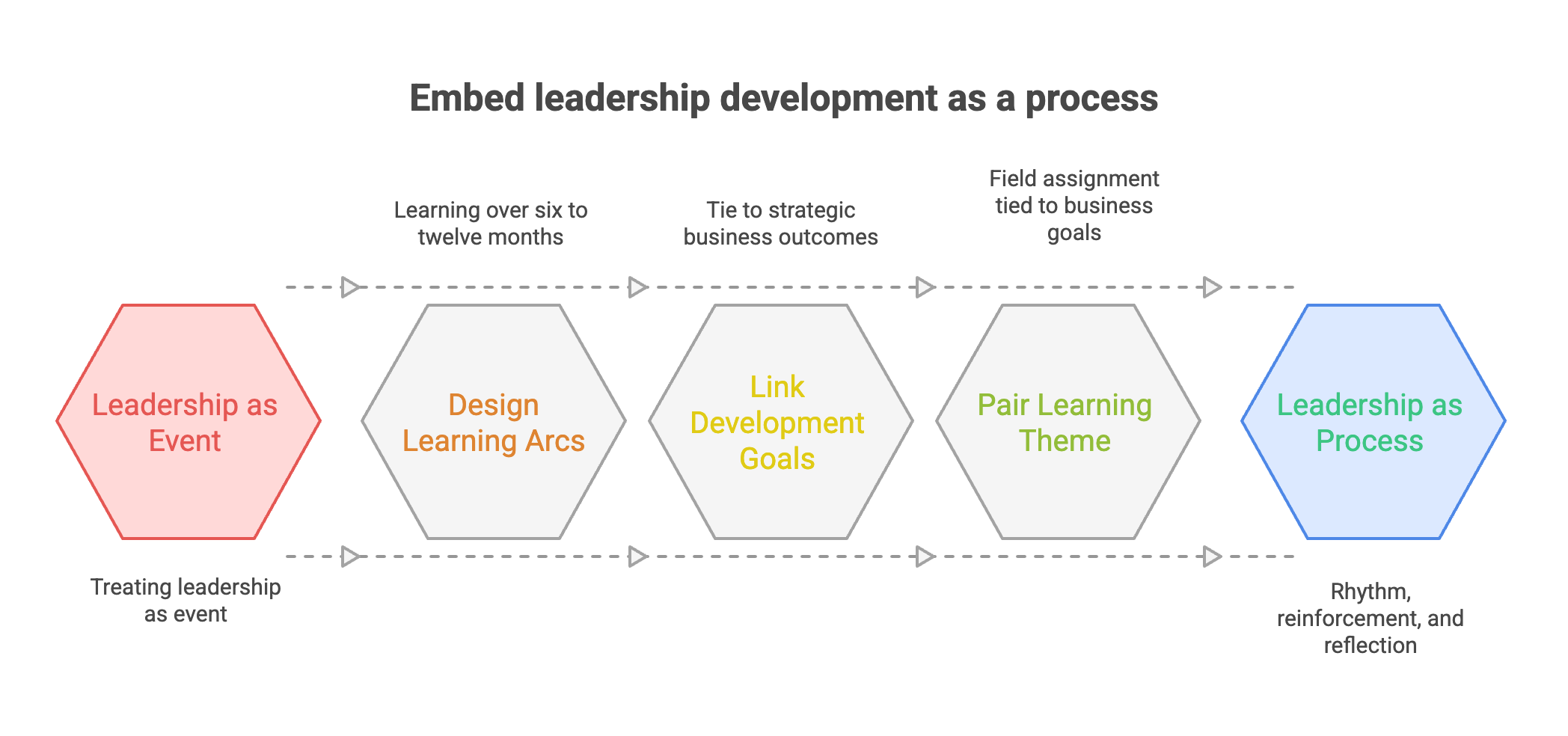
Pro Tip: Shift from “How did people rate the workshop?” to “What conversations are we now having that we weren’t before?”
What leadership capabilities does your strategy actually require in the next 12–18 months?
What would shift if you stopped treating development as an HR initiative and started owning it as a business imperative?
When done right, leadership development pays back in:
None of this happens in one off-site. It happens in a rhythm. With intent. And with humility.
If you're designing or refreshing a leadership program this quarter, start here:
Block 90 minutes with 2–3 cross-functional leaders.
Map your organisation’s top strategic tensions.
Ask: What leadership behaviours are we rewarding - and which ones do we need next?
Start there. And let’s build leadership from the inside out.
Team SHIFT
Why do so many leadership programs fail to stick?
We’ve all seen it happen: senior leaders greenlight an ambitious development program, full of off-sites, 360 feedback, and executive coaching. Everyone nods along, eager to grow. Six months later? Not much has changed. Behaviours revert. The culture barely shifts. The ROI conversation begins... and fizzles.
Here’s the real question: what actually works when it comes to leadership development? And what gets in the way?
This post draws on two decades of coaching and strategy work with leadership teams. We’ll unpack the strategies that drive lasting change, call out common misfires, and share a refined framework we’ve seen generate meaningful, measurable outcomes.
Leadership development isn’t just a perk or a pet project. At its best, it’s a force multiplier.
According to McKinsey, organisations in the top quartile for leadership effectiveness were 13 times more likely to outperform their competition on key business metrics.
This matters because leadership shapes the tone, pace, and priorities of an organisation. Culture, decision quality, team alignment, innovation velocity - all hinge on how leaders think, act, and model behaviour.
So when leadership development is done right, it unlocks competitive advantage. When done poorly, it becomes corporate theatre.
Effective leadership development isn’t built on modules. It’s built on momentum.
We call our model The 4 Levers of Sustainable Leadership Growth:
Let’s break these down.

Most programs begin with what leaders need to learn. We start with why now?
Leadership isn’t one-size-fits-all. A brilliant coaching toolkit means nothing if what’s really needed is strategic decision-making under pressure. And vice versa.
Effective programs anchor in the business context:
We’ve seen a regional bank leapfrog competitors not by generic leadership modules, but by embedding development in their pivot to digital-first customer service. Leaders practised real-time scenario planning, stakeholder communication, and cross-functional influence - because those were the muscles their transformation needed.
Reflection prompt:
Where is your business heading - and what leadership patterns will no longer serve you there?
Micro-action: Before designing your next program, run a 1-hour cross-functional pulse to identify strategic tensions and growth gaps.

Too many programs teach behaviours without challenging beliefs.
But leadership is inside-out work.
If a leader sees conflict as dangerous, no amount of “crucial conversations” training will land.
If someone believes strategy is for the C-suite only, they won’t step into system-level thinking.
We build in structured self-reflection, coaching, and leadership narratives.
Because real growth happens when people question their default scripts and choose new ones.
Take one client: a senior ops leader who always defaulted to control. Through peer coaching and reframing exercises, he saw how fear of being seen as weak shaped his style. That shift unlocked delegation, trust, and a three-fold jump in team performance scores.
Micro-action: Introduce a “beliefs audit” at the start of any development cycle. Ask:

People learn more from each other than from experts. Especially at senior levels.
We’ve seen exponential value in cross-functional peer forums. When a product head and a finance lead unpack their blind spots together, something shifts. Trust builds. Silo walls crack. Vulnerability becomes productive.
The key is structure:
And yes, it gets uncomfortable. But that’s where growth lives.
Micro-action: Create monthly “Leadership Labs” where peers bring real challenges, coach each other, and reflect out loud. Rotate facilitation.

The most common failure mode? Treating leadership development as an event, not a process.
You can’t “install” leadership like software.
You embed it through rhythm, reinforcement, and reflection.
That’s why we design learning arcs over 6–12 months, with touchpoints embedded in business meetings, coaching, and feedback loops.
It’s also why we avoid generic KPIs. Instead, we link development goals to strategic outcomes:
Micro-action: Pair each learning theme with a “field assignment” directly tied to current business goals. Then debrief in team meetings, not just in workshops.

Pro Tip: Shift from “How did people rate the workshop?” to “What conversations are we now having that we weren’t before?”
What leadership capabilities does your strategy actually require in the next 12–18 months?
What would shift if you stopped treating development as an HR initiative and started owning it as a business imperative?
When done right, leadership development pays back in:
None of this happens in one off-site. It happens in a rhythm. With intent. And with humility.
If you're designing or refreshing a leadership program this quarter, start here:
Block 90 minutes with 2–3 cross-functional leaders.
Map your organisation’s top strategic tensions.
Ask: What leadership behaviours are we rewarding - and which ones do we need next?
Start there. And let’s build leadership from the inside out.
Team SHIFT
Why do so many leadership programs fail to stick?
We’ve all seen it happen: senior leaders greenlight an ambitious development program, full of off-sites, 360 feedback, and executive coaching. Everyone nods along, eager to grow. Six months later? Not much has changed. Behaviours revert. The culture barely shifts. The ROI conversation begins... and fizzles.
Here’s the real question: what actually works when it comes to leadership development? And what gets in the way?
This post draws on two decades of coaching and strategy work with leadership teams. We’ll unpack the strategies that drive lasting change, call out common misfires, and share a refined framework we’ve seen generate meaningful, measurable outcomes.
Leadership development isn’t just a perk or a pet project. At its best, it’s a force multiplier.
According to McKinsey, organisations in the top quartile for leadership effectiveness were 13 times more likely to outperform their competition on key business metrics.
This matters because leadership shapes the tone, pace, and priorities of an organisation. Culture, decision quality, team alignment, innovation velocity - all hinge on how leaders think, act, and model behaviour.
So when leadership development is done right, it unlocks competitive advantage. When done poorly, it becomes corporate theatre.
Effective leadership development isn’t built on modules. It’s built on momentum.
We call our model The 4 Levers of Sustainable Leadership Growth:
Let’s break these down.

Most programs begin with what leaders need to learn. We start with why now?
Leadership isn’t one-size-fits-all. A brilliant coaching toolkit means nothing if what’s really needed is strategic decision-making under pressure. And vice versa.
Effective programs anchor in the business context:
We’ve seen a regional bank leapfrog competitors not by generic leadership modules, but by embedding development in their pivot to digital-first customer service. Leaders practised real-time scenario planning, stakeholder communication, and cross-functional influence - because those were the muscles their transformation needed.
Reflection prompt:
Where is your business heading - and what leadership patterns will no longer serve you there?
Micro-action: Before designing your next program, run a 1-hour cross-functional pulse to identify strategic tensions and growth gaps.

Too many programs teach behaviours without challenging beliefs.
But leadership is inside-out work.
If a leader sees conflict as dangerous, no amount of “crucial conversations” training will land.
If someone believes strategy is for the C-suite only, they won’t step into system-level thinking.
We build in structured self-reflection, coaching, and leadership narratives.
Because real growth happens when people question their default scripts and choose new ones.
Take one client: a senior ops leader who always defaulted to control. Through peer coaching and reframing exercises, he saw how fear of being seen as weak shaped his style. That shift unlocked delegation, trust, and a three-fold jump in team performance scores.
Micro-action: Introduce a “beliefs audit” at the start of any development cycle. Ask:

People learn more from each other than from experts. Especially at senior levels.
We’ve seen exponential value in cross-functional peer forums. When a product head and a finance lead unpack their blind spots together, something shifts. Trust builds. Silo walls crack. Vulnerability becomes productive.
The key is structure:
And yes, it gets uncomfortable. But that’s where growth lives.
Micro-action: Create monthly “Leadership Labs” where peers bring real challenges, coach each other, and reflect out loud. Rotate facilitation.

The most common failure mode? Treating leadership development as an event, not a process.
You can’t “install” leadership like software.
You embed it through rhythm, reinforcement, and reflection.
That’s why we design learning arcs over 6–12 months, with touchpoints embedded in business meetings, coaching, and feedback loops.
It’s also why we avoid generic KPIs. Instead, we link development goals to strategic outcomes:
Micro-action: Pair each learning theme with a “field assignment” directly tied to current business goals. Then debrief in team meetings, not just in workshops.

Pro Tip: Shift from “How did people rate the workshop?” to “What conversations are we now having that we weren’t before?”
What leadership capabilities does your strategy actually require in the next 12–18 months?
What would shift if you stopped treating development as an HR initiative and started owning it as a business imperative?
When done right, leadership development pays back in:
None of this happens in one off-site. It happens in a rhythm. With intent. And with humility.
If you're designing or refreshing a leadership program this quarter, start here:
Block 90 minutes with 2–3 cross-functional leaders.
Map your organisation’s top strategic tensions.
Ask: What leadership behaviours are we rewarding - and which ones do we need next?
Start there. And let’s build leadership from the inside out.
Team SHIFT
